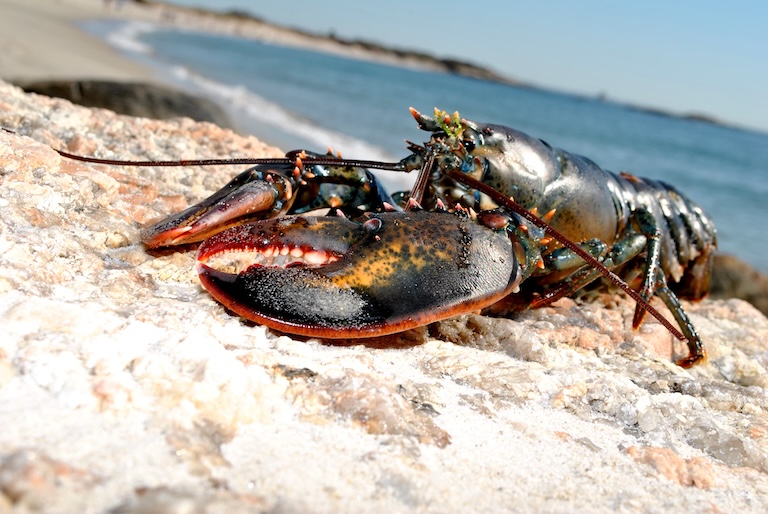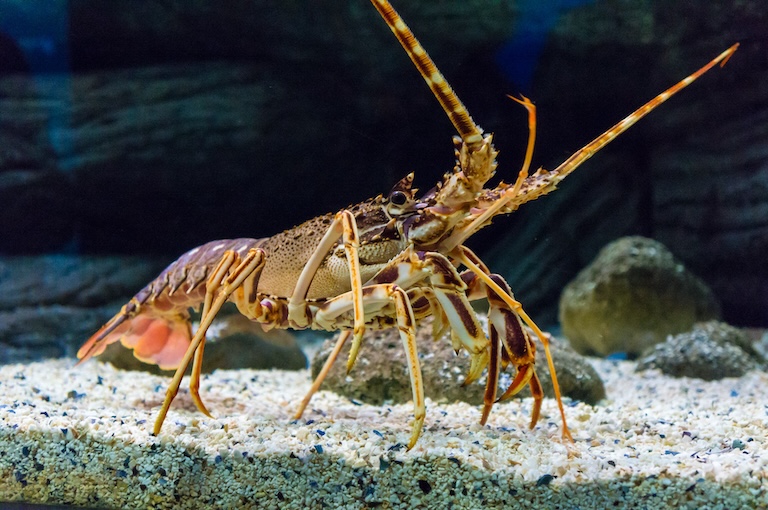Lobster Profile
In 1978, the B-52’s released a harrowing warning about the dangers of dropping your earlobe in the ocean. According to the song, rock lobsters love grabbing earlobes (also looking like rocks, and generally having a good time with sea robins and bikini whales).
But they had made a fatal error of identification. For, you see, rock lobsters have no claws with which to grab earlobes, as they are not really lobsters at all. Alas, everyone in the ‘70s was too busy twistin’ round the fire, rockin’ and fruggin’ to care.
True lobsters, on the other hand, can take your earlobe clean off.

Lobster Facts Overview
| Habitat: | Benthic marine, coastal: rocky, sandy, muddy beds |
| Location: | Worldwide |
| Lifespan: | At least 50 years |
| Size: | Up to 1m (3 ft) long |
| Weight: | Up to 20 kg (44 lb) |
| Colour: | Blues, reds, browns, oranges, yellows, |
| Diet: | Omnivorous: fish, mollusks, other crustaceans, worms, plants |
| Predators: | Fish, sharks, rays, skates, octopuses, and crabs |
| Top Speed: | 18 km/h (11 mph) |
| No. of Species: | At least 30 |
| Conservation Status: | Most Data Deficient or Least Concern (IUCN) |
Lobsters are ancient and incredible decapods from the sea bed, marching relentlessly forward like armoured robots, feeding on pretty much anything they come across.
They’re typically slow-moving but can escape like a BJJ practitioner, by shrimping quickly away. Unfortunately, no amount of shrimping can help them escape the ransacking of the world’s oceans, and they are declining in size and number.
The sad fact is that these once gargantuan crustaceans are getting smaller every year.
Interesting Lobster Facts
1. They’ve got ten legs
Lobsters are part of an order of arthropod crustaceans known as Decapods. This literally means “ten feet”, which describes pretty much all 15,000 of them, including the crabs, shrimp, hermit crabs, rock lobsters and these guys: the true lobsters.
The earliest decapods show up 455 million years back, and since then they’ve branched out into quite a few varieties, some with up to 38 appendages.
Prawns diverged from the common ancestor first, and the remaining group then split between swimmers and walkers.
Walkers then turned into what are now lobsters and their look-alikes.
Appendages are paired to a body segment, and there are always ten that are considered legs. In some families, one pair of these legs are capped with a claw, and in lobsters, several are. 1

2. Six of these have claws
There is a handful of other animals commonly known as lobsters. Squat lobsters, spiny lobsters and slipper lobsters are all lobsters in name only, and either have no claws or, in the case of squat lobsters, only have one pair.
True lobsters certainly have a pair of formidable chompers at the front, but the next two pairs of legs each have a set of secondary claws, too. This makes them highly dextrous in manipulating their world, which is often murky and hard to see in.
Still, they have remarkably good eyes.
3. They have awesome eyes
Lobster eyes are weird. Not only are they on stalks but they have a convex retina, as opposed to the more familiar concave shape in most vertebrates (incidentally, convex retinas are found in some vertebrates and nobody is quite sure how they came about).
Lobster eyes are formed of a series of mirrored square tubes that use reflection of light rather than refraction, as our lens does.
Each eye has 10,000 of these tubes bunched up at the surface, and light from an object is bounced down them to a single focal point.
This design is specifically adapted to functioning in low light, and likely doesn’t have good resolution but is highly specialised, nonetheless. The majority of its sensory input is tactile and smell-based, from a series of antennae.

4. They’re not normally bright red
One of the first things many associate with lobsters is their vivid red colouration, but this is almost always a result of the lobsters we’re familiar with being cooked.
While they’re alive, most are brown or otherwise dark in colour, some can be bright blue or yellow, and around one in 50 million will be half blue and half brown. This strange genetic anomaly is a lobster that’s half male and half female.
The familiar red colour comes from a chemical related to the orange pigment in carrots called astaxanthin, which is an antioxidant they get from their diets. It builds up in the shell, and when cooked, the heat breaks down other pigments but leaves behind the bright red shell.
Unfortunately, the boiling used to cook these animals is widely done while they’re still alive, which researchers are starting to realise, isn’t very nice. 2
5. They don’t like being boiled alive
There’s been an ongoing debate over whether “lesser” beings suffer since the dawn of hierarchy. It was once thought by doctors that babies couldn’t feel pain.
When that was debunked, it was “animals don’t feel pain”. Then, that was debunked, and the goalposts moved down a notch to invertebrates and fish.
But fish do feel pain, and all contemporary research seems to be pointing toward the suspiring emotional and sentient lives of arthropods, too. But for some reason, there’s still a debate about whether it’s okay to drop a flailing, panicking animal into a pot of boiling water.
More and more evidence is building that when a creature behaves as though it’s suffering, it is, in fact, suffering. Though there are plenty of people with vested interests who refuse to accept this. Thankfully, many countries have now made the practice of boiling a lobster alive illegal.
The truth is, regardless of whether the issue is debatable, very little is lost by painlessly euthanising the animal before boiling it.
On the other hand, there’s potential for immense suffering within the bounds of uncertainty if you don’t. 3
They’re long-lived
When they’re not being thrown to a painful death or being otherwise consumed by predators in the ocean, lobsters live for a very long time.
The estimate sits at around 50 years currently, but chances are they can live longer than this. It appears as though lobsters never stop growing, which is why, once upon a time, they were enormous.
One of the reasons for this longevity and size is possibly due to the production of telomerase, an enzyme that repairs DNA. The lack of this enzyme contributes to ageing, and diseases like cancers in other animals, so it serves the lobster pretty well and lets them grow to epic proportions.
The largest lobster ever recorded was 20kg in weight, but as people keep plucking them before they’re ripe, their size has gradually reduced. 4

7. They’re getting smaller
Lobsters were once so prevalent that they were the food of the lower classes. Lobster flesh was known as “poor man’s chicken” and was often even used for fertiliser. A combination of better preservation techniques and scarcity flipped that on its head, and now lobsters are Michelin-quality cuisine.
But they’re getting more and more expensive, despite getting less and less meaty.
Lobsters are over-harvested and unsustainably so, that the largest of them are all gone. And this decline, while perhaps not yet critical for the lobsters, is a sign of worse to come.
Lobster Fact-File Summary
Scientific Classification
| Kingdom: | Animalia |
| Phylum: | Arthropoda |
| Class: | Malacostraca |
| Order: | Decapoda |
| Family: | Nephropidae |
| Genus: | Homarus |
| Species: | gammarus/americanus |
Fact Sources & References
- “How Lobsters See, and How Lobster Eyes Work?”, Lobster Anywhere.
- “A Rainbow of Colorful Lobsters”, Smithsonian National Museum of Natural History.
- Quirks & Quarks (2018), “Do lobsters feel pain when we boil them alive?”, CBC.
- Emily Osterloff, “Are lobsters immortal?”, National History Museum.
